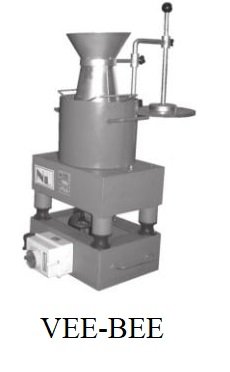The main Reason for Vee Bee Test is to Calculate workability and consistency of the Fresh concrete. Vee Bee test provides compatibility and and mobility of the concrete. The test measures the relative effort required to change a mass of concrete from one definite shape to another (i.e., from conical to cylindrical) by means of vibration. The amount of effort is taken as the time in seconds, required to complete the change. The results of this test are of value when studying the mobility of the masses of concrete made with varying amounts of water, cement and with various types of grading of aggregate. The time required for complete remoulding in seconds is considered as a measure of workability and is expressed as the number of Vee-Bee seconds. The method is suitable for dry concrete. For concrete of slump in excess of 50mm, the remoulding is so quick that the time cannot measured.
Significance: –
Vee bee consistometer test is named after the developer V Bahrmer of Sweden. It measure the relative effort led by concrete to change from one definite shape to another definite shape by conducting vibration. This is ho it helps to find out workability and compatibility of the concrete.
Apparatus Required: –
Vee Bee Test Machine
- A vibrator table resting upon elastic supports
- A metal pot
- A sheet metal cone, open at both ends
- A standard iron rod, Tamper (20 mm in diameter and 500 mm length)

Weigh Scale: – To measure weights

Procedure: –
- Slump Test is performed, placing the slump cone inside the sheet metal cylindrical pot of the consistometer.
- The glass disc attached to the swivel arm shall be moved and placed just on the top of the slump cone in the pot and before the cone is lifted up, the position of the concrete cone shall be noted by adjusting the glass disc attached to the swivel arm. The cone shall then be lifted up and the slump noted on the graduated rod by lowering the glass disc on top of the concrete cone. The electrical vibrator shall then be switched on and the concrete shall be allowed to spread out in the pot.
- The vibration is continued till such a time as the conical shape of the concrete disappears and the concrete assumes a cylindrical shape. This can be judged by observing the glass disc from the top for disappearance of transparency.
- Immediately when the concrete fully assumes a cylindrical shape, the stop watch is switched off. The time required for the shape of concrete to change from slump cone shape to cylindrical shape in seconds is known as Vee Bee Degree.
- This method is very suitable for very dry concrete whose slump value cannot be measured by Slump Test, but the vibration is too vigorous for concrete with a slump greater than about 50 mm.
- The time required for the shape of concrete to change from slump cone shape to cylindrical shape in seconds is known as Vee Bee Degree
Calculations: –
- The Vee Bee Degree of concrete ……… second(s) indicate Low/ Medium/ High Degree of workability
| Work Description | Workability Measurement | Vee-Bee time (seconds) | |
|---|---|---|---|
| Slump (mm) | Compaction Factor | ||
| Moist earth | – | – | 40 to 25-20 |
| Very Dry | – | 0.70 | 20 to 15-10 |
| Dry | 0 – 25 | 0.75 | 10 to 7-5 |
| Plastic | 25 – 50 | 0.85 | 5 to 4-3 |
| Semi Fluid | 75 – 100 | 0.90 | 3 to 2-1 |
| Fluid | 150 – 175 | 0.95 | More Fluid than 1 |